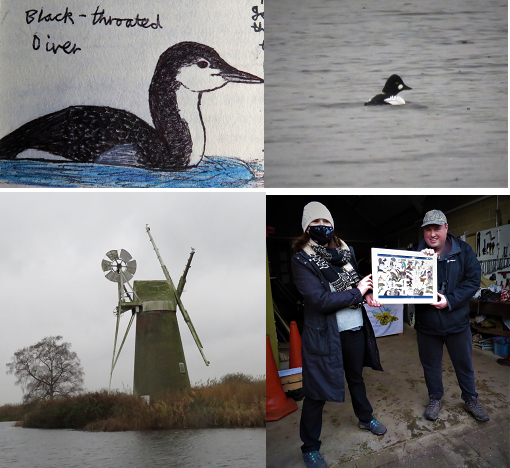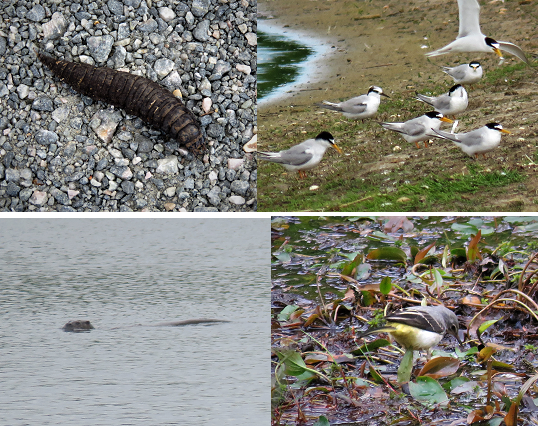Dec 1st Strumpshaw Fen
It was a very windy start to December. It seemed everything was hunkering down for safety as there wasn't a lot around at all. Marsh harriers, the odd buzzard, a few mallards and a pair of swan were the only things brave enough to be seen from Reception Hide. The feeders were more busier with marsh tits among all the usual suspects braving the strong gusts to feed. Other than that, it was a rubbish day.
Dec 4th Cley
There was a gap in the wet weather to go out to Cley for a spot of sea watching. That afternoon, Mum dropped me off at the beach and left me to it for a while. For some time, I was the only person with a scope at the beach shelter as I attempted to find something interesting on my own as a short spell of rain occurred. I found some large-ish guillemot like things far out at sea, but I wasn't confident enough to turn them into anything else. Looking back at my dodgy distant and blurry photos back at the comfort of my home much later on, I discovered one was a puffin! The photo wasn't worth keeping, but I could see a white roundish head with a few pixels that resembled a red bill. Nothing else it could have been!
Thankfully, some expert sea watchers did arrive and they helped me find, not just a Caspian gull, but also my first ever black-throated diver! It was tricky to look at, let alone photograph, as it kept diving so much around the area of the old ship wreck that now protrudes from the surface. It was the size of the several cormorants that were nearby and much blacker than a red-throated diver, but with white sides that were just visible over the bobbing waves. A great bird, though I could only manage one photo of it and it was terrible. I wish I could get a better photo of one some day. Also seen were guillemots, razorbill, turnstones, wigeon, brent geese, great black-backed, herring, common and black-headed gulls and a grey seal. In the end of the day, my tally grew to 161 bird species.
 |
| Black-throated Diver (Dec 4th), Goldeneye & How Hill Windmill (Dec 6th) and me presenting my drawing (Dec 10th) |
Dec 6th Barton Broad & River Ant
I had a nice surprise during my previous shift at Strumpshaw as my Reception Hide colleague, Tricia, invited me to a boat trip. I travelled to Wroxham by train to meet up with her, who then drove me to the boat that we and Tricia's co-driver were going to take me on an afternoon's ride around Barton Broad and up the River Ant as far as How Hill before heading back to base. However, the weather was horrendous, but thankfully this was an enclosed electric boat, so at least I was going to be dry.
Tricia started the engine and made our way to Barton Broad, before her co-driver took over the wheel. On the broad, we counted around 30 goldeneyes, which were very skittish and difficult to photograph in the bad weather and light conditions while on a moving boat. I did, however, witness a few males display to the females by flipping their head onto their backs. We also saw tufted ducks, herons, great crested grebes, cormorants and mute swans and, along the River Ant, 2 little grebes. It was an interesting ride, despite the relentless torrential downpour. Unfortunately, I left the boat with a bump as I slipped over on the unusually steep metal gangplank and I fell onto my backside! OUCH!
Dec 8th Strumpshaw Fen
Strong winds again! Nothing much to see, again! I served more coffees than birds seen this morning. I did see the odd siskin in the woods, the usual birds on the feeders, a buzzard and a few marsh harriers braving these blustery conditions and 4 mallards and a teal in front of Reception Hide as well as a flock of greylags and a cormorant in the distance and a kestrel on the walk back to Brundall station. In the end, nothing much to get excited about.
Dec 10th Mousehold Heath & Strumpshaw Fen
It was to be a busy day. First was a food shop. Then was the first of two walks starting at Mousehold in the morning. I joined Will, Peter and their group of two others for a short walk around the heath to look for birds and just to catch up on things. Coal tits, magpies, a couple of common gulls and the usual blue, great and long-tailed tits, chaffinches, etc made up the list before heading back for lunch. I didn't stay, however, I had to get to my second walk at Strumpshaw.
Mum picked me up and dropped me off at the reserve before the walk even began. This was a short walk to the river and back with the large group of staff and volunteers. We didn't really see that much, but it wasn't really about seeing wildlife, it was about having a get together with everyone involved with Strumpshaw. This was the first Christmas gathering for two years now and after the walk, we listened to what had happened this year behind the scenes on the reserve. And I showed everyone my gift that I made for Strumpshaw, a drawing of the wildlife I've seen over the past 10 years since I've volunteered here and to celebrate 45 years of the reserve since the RSPB took it over. It was well received by everyone. I was so pleased as it took a few months to do.
Dec 15th Strumpshaw Fen
A fairly warm and lovely day for December. From Fen Hide, I had a very brief otter appearance, arriving from the left and vanishing from the left within a few seconds. From Reception Hide, there was a brief bearded tit sighting, while the marsh harriers and buzzards circled the sky, two of each. I also saw siskins, pink-footed geese, mallard, gadwall and, at the end of my shift, a great spotted woodpecker was on the feeders.
Dec 19th R.I.P Grandad (Rex Blyth) 1934- 2021
With just a week to go before Christmas, I woke up this morning to some very sad news. My grandad had passed away aged 87. He wasn't exactly a bird watcher or anything, but he would always support my interest in wildlife and always asked me what I've seen lately.
I remember back in 2003 after graduating from school, I spent a week with my grandparents and they took me around the county in their campervan. One evening, we were driving back from somewhere and we came across a barn owl flying over a field. I can remember how pleased they were at the time as it was probably the first time they've experienced a wildlife encounter like that with me. Later that week, Grandad took me for a walk along Blakney Harbour, the only time we ever bird watched together just me and him. At the time, I believe we glimpsed a black redstart on the beach and we had a sedge warbler singing right by our feet.
Years later, during a visit to my grandparent's house, I was watching the birds on his feeders. Suddenly a brambling appeared from nowhere and I recall Grandad being delighted as he never even heard of such a bird and would have passed it for just a chaffinch if it wasn't for me. These moments of me, him and encounters with wildlife were rare and few and far between, but I will never forget them.
Dec 22nd Strumpshaw Fen
It was a beautiful frosty morning, my last shift before Christmas. Haw frost covered everything and transformed the vegetation into ice-covered sculptures. It was like a winter wonderland. Even the reserve's Highland cattle were covered in frost and looking like a festive image that deserves to be on the front of a Christmas card before I watched Strumpshaw warden Matt and his team moved them onto another pasture. It was pretty much a morning I needed to reflect on things after Grandad passed away. I was more admiring the frost than finding wildlife. However, I did manage to find siskins, a muntjac deer, a great crested grebe, pink-footed geese and Canada geese.
 |
| Great Spotted Woodpecker (Dec 15th), Frost on Oak leaves, Burdock & Highland Cow (Dec 22nd) Robin (Dec 22nd) And Tufted Ducks (Dec 29th) |
The Reception Hide was a chilly place even with the heaters on. My toes were numb by the end of my shift. It was freezing! Most of the broad was frozen apart from the area around the reedy islands and at the back of the broad, in which attracted a large number of mallards, gadwall, shovelers and teal, 2 mute swans and the odd marsh harrier and buzzard. A really beautiful day, but too cold for me!
Dec 29th Strumpshaw Fen
My final shift of 2021 was a miserable one as it was raining. On the plus side, it wasn't very cold like last week, just dull, grey and on the damp side of things. The ducks didn't seem to mind at least. The broad was absolutely full of gadwall, mallard and greylag geese with around 10 teal and 10 shovelers and a pair of tufted ducks and mute swans as well as my first coot outside Reception Hide for a long while. I'm pleased in the coot because they usually over winter here at Strumpshaw in large numbers, since last winter, however, I haven't seen many at all. I was quite concerned.
Also seen today were marsh harriers and buzzards, a flock of lapwing flying by and, to round up the year nicely was an otter! It spooked everything off the broad while busy hunting behind the reedy island area, being very tricky to follow its every move.
Dec 31st Mousehold Heath
My 12 and final dawn chorus of the year on the final day of the year and I decided to do it at Mousehold. I arrived just before 7am, while it was still dark, listening to the robins, wrens, alarm calling blackbirds, cawing crows and a song thrush. It all seemed too promising. On the walk up, it was dry, a bit muddy underfoot, but no rain in sight. That is, until I sat down to get my camera out. It wasn't too bad at first, short on and off outbursts that didn't last for that long. However, it all changed to a heavy downpour and I was getting soaked in an instant. I had to abandon my walk and leave for home as soon as possible. Typical that while writing this, the rain has gone and it's now a lovely, sunny day!
What a way to end my 2021 dawn chorus challenge. And what a way to end 2021 as a whole. It has been a very challenging year. Covid has yet again made it a very rubbish-y year, though, for at least the first 6 months, I was actually enjoying myself finding as many birds as I could within or just a few miles from the city whilst in lockdown. I had a lot more freedom than I did for the majority of 2020, but I felt the latter 6 months of 2021 to be the hardest. Especially now with my grandad passing away just before Christmas. It has been extremely tough. I can only hope that 2022 surpasses 2020 and 2021 combined. I haven't even planned what challenge I want to do for next year yet, but I will keep you posted. Happy New Year everyone!













